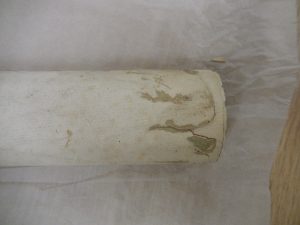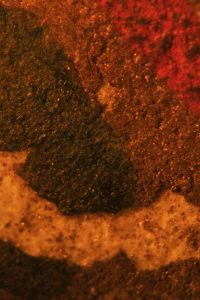New Blog Post
New text

The scroll was not accessible for viewing without risking further damage. The condition it was in came both from the inherent vice of instable materials used in its making, and its previous storage and handling. Immediate issues were:
- The borders and delimitations of panels were severely embrittled, causing fracturing and losses due to the use of verdigris (a copper oxide-based pigment)
- The scroll had severed in two sections along a crease, exacerbated by copper corrosion, and a long tear between two panels risked the same fate.
- Metallic gilding was flaking throughout the scroll and some organic pigments’ binder had cracked.
- Finally, each section had been stored rolled with no support, making handling incredibly difficult and precarious, as the scroll tensed to a tight roll.

The aim of the conservation treatment was to remediate these issues and to stabilize the object for occasional handling and exhibition.
Treatment first focused on consolidating the flaking media, by re-introducing an adhesive between the pigment and the paper support. This is to ensure no further losses would take place with handling. The adhesive, Aquazol, was chosen based on its flexible mechanical properties, allowing for rolling of the scroll.
Many paper repairs were also necessary to support fractures and brittle areas which were likely to also break with further handling. This was done by adhering a supportive tissue to the back of affected areas to locally increase mechanical strength. As copper ions are water-soluble, limited moisture could be introduced in the repair stage to prevent furthering the damage areas. This was remediated by using remoistenable tissue, a tissue pre-coated with adhesive which is allowed to dry, and is re-activated with minimal moisture before use. Both of these treatment options required prior testing of materials used in order to ensure their ethical, functional, and aesthetic suitability.


To ensure proper protective storage of the scroll, each section was rolled onto supportive cores within a bespoke box to house both side-by-side. While re-joining the two sections was an obvious treatment choice for better legibility and to return the scroll to its original form, keeping them separate was more practicable to aid handling, which was agreed with the Royal Asiatic Society. To prevent future over-handling of the scroll, high-quality photographs of each panel were delivered to the RAS together with a printed-out visual guide and handling instructions.
Formerly an uncatalogued object in an unstable condition, the scroll is now safely accessible for further research on its identity and history.
Mathilde Renauld
The article, ‘An Illustrated Shiʿi Pilgrimage Scroll in the Collections of the Royal Asiatic Society’, which was written by Mathilde and Professor Ulrich Marzolph, is now available to read for RAS members on First View
To view this article, members are reminded to login to the RAS website with their unique username and password to view the Journal.
We would like to thank Mathilde for her contribution to this week’s blog post. This week’s virtual Collections Evening, which celebrates ongoing work with the collections during the pandemic, is also a good opportunity to refresh our memory about similar occasions in years past, when Mathilde joined us at Stephenson Way to describe her work with this pilgrimage scroll: https://royalasiaticsociety.org/celebrating-our-collections/
We look forward to more exciting projects in the months and years to come.

